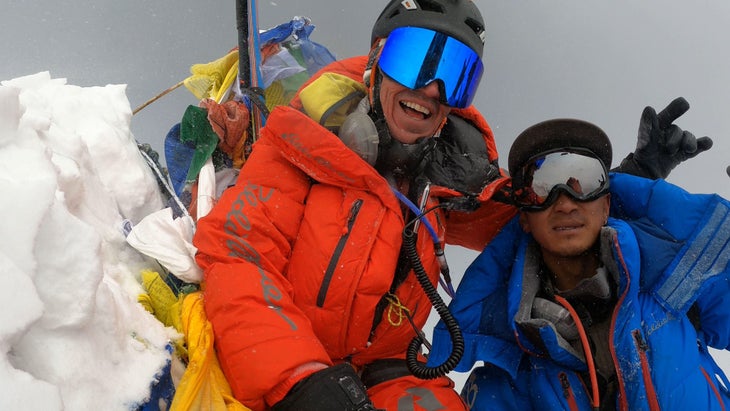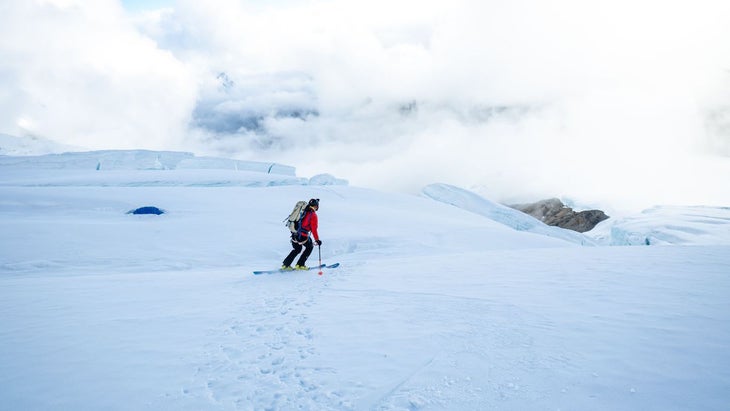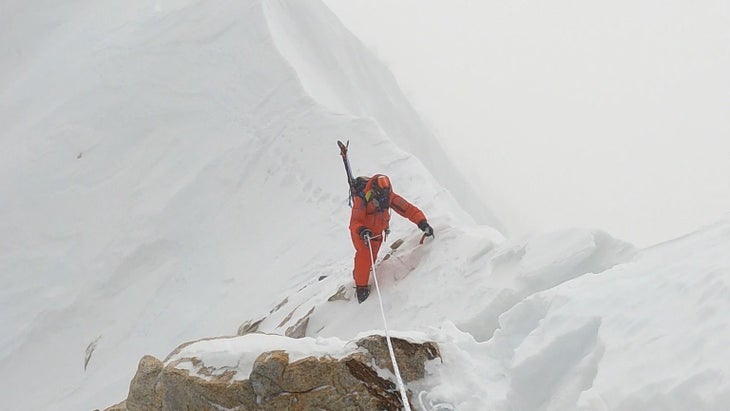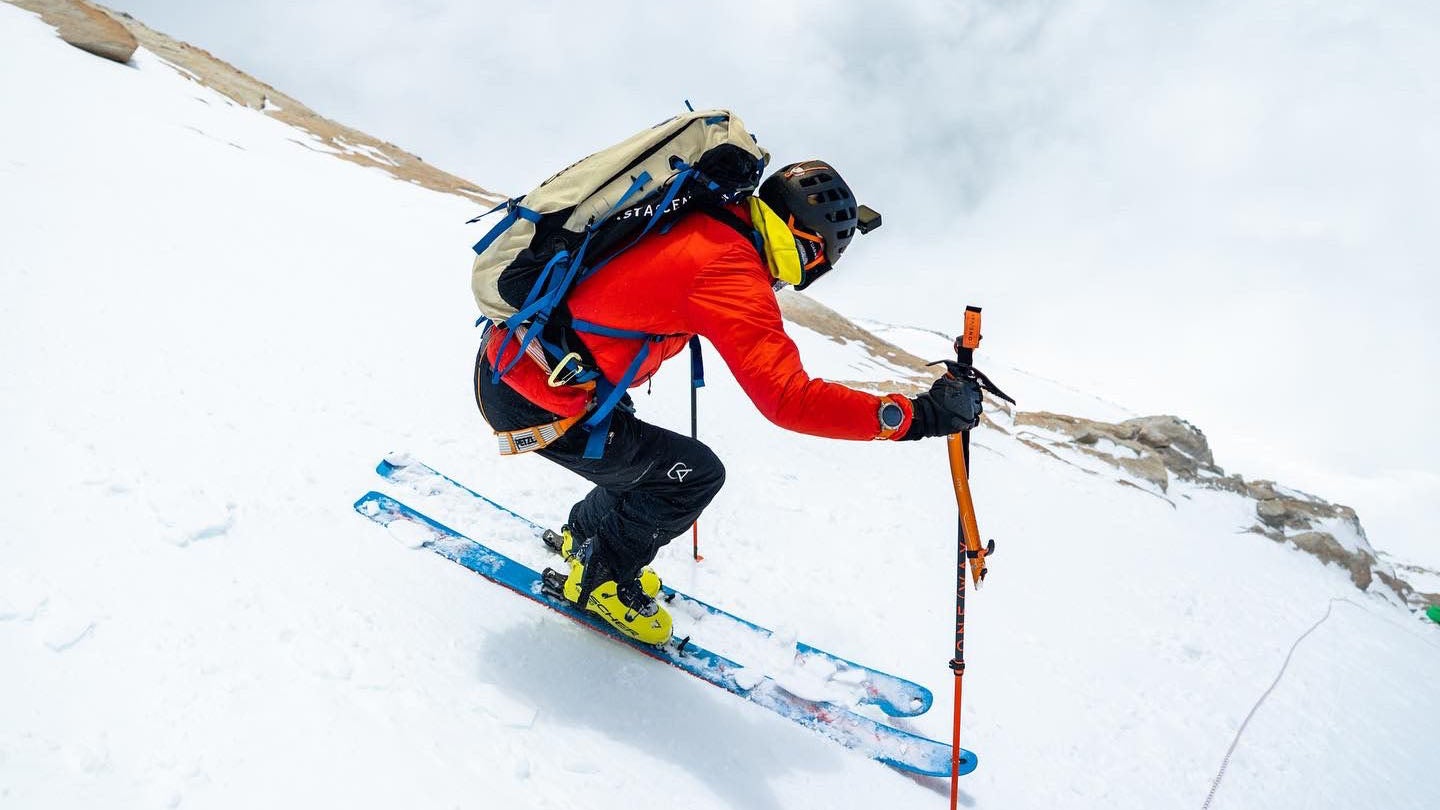On Monday, alpinist Adrian Ballinger completed the first recorded ski descent from the true summit of 27,766-foot Makalu, the world’s fifth-highest mountain.
Ballinger, along with his climbing partners Dorji Sonam Sherpa and Pasang Sherpa, reached the peak’s summit on Monday at 9 A.M. amid whiteout conditions. They were the first team to reach Makalu’s summit this year, and they topped out after Dorji Sonam fixed ropes on the final exposed and technical ridge. Ballinger didn’t spend much time on top; after resting for ten minutes or so to snap a few photos, he climbed down the exposed ridge, past a handful of climbers making their way up, and then stepped into his skis and pointed them downhill.
In the steadily evolving game of high-altitude mountaineering, elite climbers are always looking for new ways to set records and push the limits of exploration. Ballinger believes that skiing the high peaks presents the ultimate challenge.

“Skiing has always been my deepest passion as a human since I was a kid,” he told �����ԹϺ���. “And then I have this talent and career of climbing 8,000-meter peaks. The combination of the two was really natural for me.”
After scoring the first descent from the true summit of Manaslu (26,781 feet) in 2011, Balligner skied Cho Oyu (26,864 feet) twice. He also embarked on unsuccessful attempts to ski 27,940-foot Lhotse and Mount Everest. Ballinger attempted to ski Makalu in 2012 and 2015.
“Makalu was the one that never let go of me, because it’s such a technical mountain,” Ballinger says. “It’s so big. It’s so rocky and burly. And as of yesterday, it was one of only two 8,000-meter peaks left that hadn’t seen a ski descent yet.”
The journey included a mix of skiing, traversing, and rappelling. As Ballinger skied from the summit in the whiteout, he dropped into a dangerous section called the French Couloir and followed a steep line down to the top of a 180-foot sheer rock face, where he had to fix a rope, remove his skis, and rappel. After navigating the cliff, Ballinger skied to Camp 3, carving through hardpack snow, where he met his teammates and photographer Griffin Mims. Ballinger stopped at the camp to warm his feet and drink coffee and then departed to navigate the route’s most dangerous section: the icy Makalu La face that separates Camp 3 from Camp 2.

As he skied down that section, Ballinger passed 25 or so climbers and sherpas who were making their way toward the summit.
“I decided to stay relatively close to the climbing line because the rope gave me a landmark for finding my way down,” Ballinger says. “It was pretty fun to be making turns past a lot of these guys—some were really psyched, some were like ‘that’s crazy!,’ and some were like ‘please get on the ropes!’”
Below Camp 2, the route on Makalu is less exposed, so Ballinger was able to ski to the glacial foot of the mountain. “It wasn’t good skiing, but it was great skiing,” he says.
Ballinger removed his skis at approximately 19,000 feet. He had skied more than 8,000 vertical feet, with around 200 feet of rappelling and the initial 50 feet of downclimbing. Ballinger says the descent was tougher than he anticipated due to the stiffness of the snowpack.
“It turned out to be more high-consequence skiing than I wanted going into it,” Ballinger says. “But the fact is that I only had to take my skis off for 60 meters, and based on how rocky and technical the mountain looks and the reputation it has, I was just so psyched.”

Ballinger, who runs the California-based Alpenglow Expeditions, was not the only person chasing a record on Makalu on Monday. His teammates Karl Egloff and Nicolas Miranda attempted to set a fastest-known time (FKT) for ascending the mountain without supplemental oxygen; they climbed from advanced base camp to the summit in 17 hours and 18 minutes, which is believed to be the new record. The duo completed the round-trip journey from base camp to the summit and back to camp in a punishing 26-hour push.
“We arrived at the base camp exhausted, physically destroyed, but happy!” Egloff .
Ballinger, Egloff, Miranda, and the rest of the Alpenglow Expeditions team relied on technological innovations and new climbing techniques for this expedition. Prior to traveling to Nepal, every member of the team used a hypoxic altitude tent to acclimatize to the thin air. The climbers also skipped the grueling 16-day day trek from Kathmandu to Makalu’s Hillary Base Camp at 16,000 feet by flying there in a helicopter—a practice that more mountaineers are following. Within 48 hours of arriving, the team quickly ascended to their main camp at 19,000 feet, which is far higher than a typical base for Himalayan expeditions.
Ballinger says the process the team followed on Makalu was born out of a decade of studying the preacclimatization process. “What I’ve now noticed is that people are so much less likely to get sick in the initial days and weeks of the trip—anything from upper respiratory infections to lower gastrointestinal infections to actual altitude ailments,” he says. “Since our body is preacclimatized, we’re able to more effectively fight off all those different things that are part of big mountain expeditions.”

Ballinger rose to fame in 2019 by completing successful expeditions to Mount Everest and K2 without supplemental oxygen. These days, he’s targeting mountaineering goals away from the world’s highest peak. In fact, he has decided to no longer lead expeditions on Everest from the Nepali side.
“The Nepali mismanagement of the south side, combined with the danger of the Khumbu Icefall, is such that, as an IFMGA mountain guide, I can’t look at that side of the mountain and think that I can run a trip that I’m proud of,” he says. “It’s everything from the dramatic, inexperienced levels of the climbers and many of the sherpas now working on the mountains to the new expedition operators. All of this inexperience is combining for traffic jams and just a pretty ugly scene.”
Ballinger believes Everest’s north side, which sits in China, now boasts superior management.
“That’s everything from kicking out a lot of the companies that aren’t maintaining standards to effectively managing trash and human waste,” he says. “And they’re really limiting the numbers of climbers allowed each season.”
Ballinger’s successful skiing of Makalu leaves just one of the world’s 14 peaks above 8,000 meters without a successful ski descent: 28,169-foot Kanchenjunga. When asked in a WhatsApp exchange if he has additional ski mountaineering goals, Ballinger was slow to respond.
“I truly want to sit with this one and be content for a bit. I feel that the immediate need in climbing and skiing to move on to the next bigger objective carries a lot of risk, and maybe not for the right reasons,” he said. “Hahahahhah, but with that high and mighty stance…Kanchenjunga is the last unskied 8,000-meter peak.”


